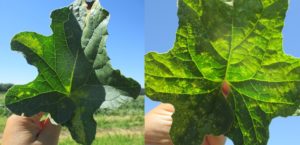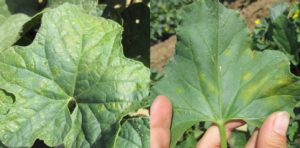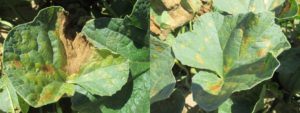Manganese toxicity is a common problem for cantaloupes growing in sandy soils across southwestern Indiana. Because symptom of manganese toxicity can easily be confused with foliar diseases, growers may misdiagnose the problem and waste fungicides by spraying for nonexistent diseases. As we now know that manganese toxicity is a nutrient related disorder caused by low soil pH, it is important for growers to learn the symptom and address the problem in right directions.
Manganese toxicity can develop on both cantaloupes and watermelons. But the symptom is more often observed on cantaloupes as they are more sensitive to acid soil conditions than are watermelons. The symptom on cantaloupes is first noticed when light green to yellow color shows between the veins on older leaves (Figure 1). Look at the leaves toward the sun and you will notice the chlorosis is formed by numerous tiny light green to yellow pin-hole type spots growing together (Figure 2). As the affected tissue dies, yellow areas become necrosis (Figure 3). Affected leaves may stand erect after the entire leaflet has died and dried out (Figure 4). The rapid breakdown and death of older leaves dramatically reduces plant photosynthesis rate and may cause considerable yield loss (Figure 5).

Figure 2. chlorosis of manganese toxicity is formed by numerous tiny pin-hole type spots growing together.

Figure 4. Cantaloupe leaves affected by manganese toxicity may stand erect after the entire leaflet died and dried out.
Dr. James Simon and others noticed most of the foliar degeneration on cantaloupes occurred in the fields or sections of the fields with acid soils (pH ≤5.5) back to 1980s. By conducting a comprehensive survey of soil pH, complimented with tissue analysis of cantaloupes growing in southwestern Indiana, Scientists confirmed that two nutrient elements that are out of desirable range cause the foliage injuries on cantaloupes in southwestern Indiana. One of them is Manganese. Manganese is most abundant in soils with high iron content such as the soils in southwestern Indiana. It exists in soil solution as either Mn2+ or Mn3+. Plants take up manganese in the form of Mn2+. The proportion of exchangeable Mn2+ increases dramatically as soil pH decreases, and the reaction is promoted in waterlogged soils.
The symptom was observed in cantaloupe research trials at the Southwest Purdue Ag. Center this year. The research plot where we have observed the symptom has initial pH of 5.6. The soil was limed with pelletized lime at the rate of 200 lbs per acre in the spring. After laying plastic, we experienced heavy rainfalls in the early May that resulted in flooding of the adjacent field. Four weeks after transplanting when the symptom was first observed, soil pH around the root zones of affected plants was 5.1. Manganese toxicity was observed in the cantaloupe variety trial this year, which provides us an opportunity to observe relative tolerance to the nutritional disorder of different varieties. Interestingly, we noticed that some of the long shelf-life cantaloupe varieties seem more susceptible to this physiological disorder than traditional eastern-type cantaloupes.
Properly limed the soil is essential to maintain soil pH in the desirable range during the season. Lime is recommended to be applied in the fall for full reaction. If manganese toxicity is detected during the season, there is not much we can do to alleviate the problem, especially when fertigation is not applicable. If the system is set up to apply fertigation through drip tapes, using fertilizers with nitrogen source from nitrate-nitrogen (calcium nitrate and potassium nitrate) instead of ammonium-nitrogen may help by increasing soil pH. Potassium carbonate can also raise soil pH. It is water soluble and can be applied through drip systems. However, as correcting soil pH can be a prolonged process, it may be too late to see a yield response in the current season if the symptom has already been noticed. Emphasis should be always placed on correcting soil pH problem prior to season starts.


